How Can I Make the My Acrylic Nails White Again
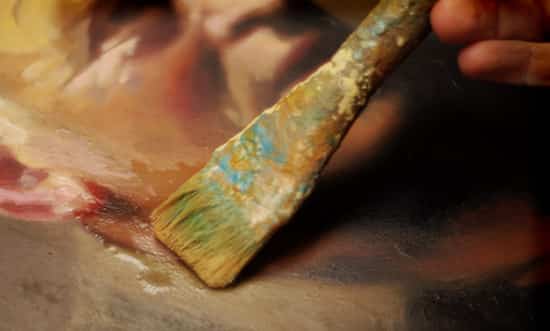
We've all done it.
Spent hours, days, even weeks slaving away on a painting, but when we finally utilize a varnish…it all goes horribly wrong.
The anxiousness builds.
You lot're at present sure there are mismatched sheens on the surface, and it was perfect before you started varnishing!
Or maybe you thought it was a practiced thought to wrap your newly varnished painting with bubble wrap just before the deadline of an exhibition, only to find out at the private view the bubble wrap had left hundreds of tiny circle imprints on the surface of the painting….mmm..surely no one would always do that!
The anxiety and disappointment that comes with varnishing tin can sometimes seem too much.
With all the confusion, conflicting advice and frustration in creating the perfect varnish end, yous can't aid wondering, what'south the point of varnishing at all?…
Traditionally varnishes were applied to keep paintings protected from all the dust, clay, smoke etc.. in the atmosphere. The varnish provides a non-porous, protective layer that is removable for conservation purposes; it serves its aesthetic purpose whilst as well providing protection.
Any dirt fastened to the painting volition be on the varnish layer and not embedded in the paint layer.
So when a painting has yellowed and looks suitably dirty, the varnish can exist removed (and all the dirt with it), restoring the painting to its vibrant, former celebrity, then a new varnish can be applied to protect it for the next 100 years or then.

Portrait of a lady with a canis familiaris 1590s, Lavinia Fontana 1552-1614 (Rebecca Gregg Conservation midpoint through a varnish removal)
As I mention beneath, there are other aesthetic reasons to varnish. All the same, information technology's worth remembering that although it'due south often called a 'Final picture show varnish', traditionally, varnishes are meant to accept the chapters to exist removed without dissentious the painting.
It's worth noting in that location are many Acrylic permanent 'non-removable varnishes on the marketplace. They will give you a nice even cease to your work – without going through the process below.
Personally, I always work with a removable varnish to ensure the hereafter preservation of the aesthetics of my paintings.
Is removable varnishing advisable for you?
I always think of portraits and paintings handed down to generations in the future it is definitely worth varnishing with an quondam school technique. However, information technology'due south a personal call every bit I capeesh some of our paintings end up on the neighbour's wall. It might be in this scenario an acrylic permanent 'non-removable varnish fits the job.
Whatsoever you lot decide is best for y'all and your paintings, it's always worth knowing good professional do.
And so we shall behave on as if all of your paintings will someday hang in the Musée du Louvre!
The main iii reasons why artists varnish their work:
i. Deepen (saturate) the colours:
Although nosotros volition be looking at acrylic varnishing techniques, the anxiety over how to varnish or what to varnish with stems back to Fresco paintings.
In his book The Craftsman's Handbook, Cennino Cennini (almost 1370–virtually 1440) tried to create a matte varnish to his paintings; he created a recipe for varnish from whipped eggwhites. The only result was it went greyness over time.
Then with the Renaissance, a more loftier gloss varnish finish was favoured, giving the paintings the "Old Master Glow" and helping to requite a permanent enrichment to the colours.
Acrylic paintings tin can oft expect ho-hum when they're dry, and some manufacturers such every bit Old Holland and Winsor & Newton have started to add a sleeky acrylic binder to give the paints a more satin advent.
Even though that helps to get the almost saturated colour from your acrylic painting, a glossy varnish will e'er enhance your colours more simply using paint alone.
2. Create an fifty-fifty gloss/satin/matte sheen over the entire picture surface.
Some acrylic pigments dry shinier than others.
Different mediums and gels also have dissimilar finishes, and on top of that, acrylic paint changes in sheen depending on how much h2o is added to the pigment.
This result is a finished painting with areas of different sheens.
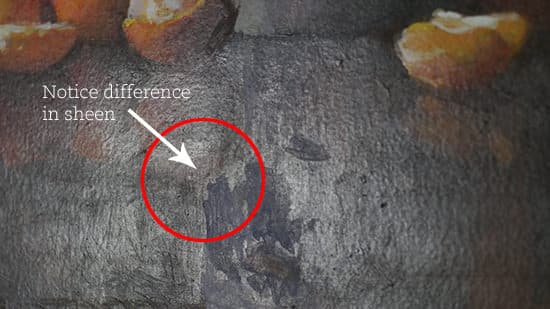
You tin see in this painting there are uneven levels of sheen due to parts where I've mixed a gloss glazing liquid into my paint and then worked water-thinned paint over the top.
Then tin I paint a varnish straight onto my acrylic painting to unify the advent?
Well, yep and no.
If yous want your acrylic painting in the hereafter to be easily cleaned/restored to the same finish every bit when you paint it, i.east. remove and replace the varnish – then you need to apply an isolation coat start.
A Note for Oil painters
If y'all were varnishing your oil painting (or deciding to use a non-removable acrylic varnish ), the process is slightly different. Y'all tin normally paint your varnish directly onto the pigment layer without the need for an isolation coat.
An Isolation Coat
This does all the heavy lifting for y'all.
By painting an isolation glaze, it provides an even sheen and a glass-similar surface, so when yous utilize the last varnish, it will just glide on. It's a chip like laying a sparse glass sheet over the paint surface and then applying a varnish to the glass.
Then rather than the varnish soaking into sections of absorbent canvas, it 'sits on top of the isolation coat.
Northward.B. An isolation coat has to be washed with a gloss medium. When it's dry, you can so apply varnish of either Matte, Satin or Gloss depending on your gustation which will ever supersede the glossy isolation coat finish.
How do you lot mix an isolation coat?
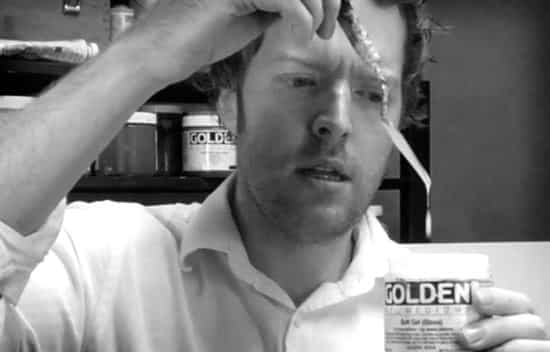
Mix the isolation coat to the consistency of single foam
I use products from Golden Acrylics. Liquitex, Winsor & Newton and Atelier Interactive all have slightly different medium choices, but the same principles apply.
Golden Soft Gel Gloss – it must be the gloss version; the satin and matte version of soft gel is not recommended due to the matting agent in the medium. The gloss will dry the clearest of the gels. Fifty-fifty if you want to finish with a Matte surface, utilize the gloss isolation glaze.
- 2 parts Soft Gel Gloss
- i role h2o
And then in the future, if y'all ever need to supercede the varnish, you tin utilise a varnish remover, and it will become dorsum to the isolation coat and never hit the acrylic paint surface.
Common questions nearly how I use an isolation coat:
Q. Why do yous employ a brush?
A. Most of my paintings are quite sparse in an application; at that place aren't whatsoever thick impasto areas, so the brush glides over very easily, and I tin work quicker.
Q. Why don't y'all spray your isolation coat?
A. If you are working on a very large-scale painting and wanted a super, super even finish, and then spray application will e'er give you the evenest sheen stop; nonetheless, it is more costly. It would assist if you had a very well ventilated area. Ideally exterior.
You would as well need to utilise a different medium than the Soft Gel Gloss.
For a spray application of an isolation coat
For a spray application, Soft Gel Gloss will exist besides viscid to go cleanly through the airbrush; if you lot desire to spray, use a mix of:
2 parts – Golden GAC-500
one part – Transparent Airbrush Extender
Apply multiple thin layers depending on the absorbency of the surface you lot're spraying. It'due south quite a lot of extra endeavor.
Q. Practice you ever utilise a sponge to apply an isolation coat?
A. No, a sponge tends to cause barm and bubbles in the isolation coat simply can be used when applying certain h2o-based varnishes.
Q.What is the biggest isolation glaze application problem?
A. Working too slow.
Going over a virtually dry section of the isolation coat with your brush.
Trying to cover a large area in one go.
Applying the isolation coat with bubbles in the mix.
Trying to terminate with i thick coat, where ii thin coats would be better.
Deciding on the level of the sheen of your varnish
It'southward a personal preference.
Many of the Impressionists preferred non to varnish at all. They didn't similar the visual effect or the ostentatious experience of a highly glossed surface.
"The Matte surfaces favoured by impressionists and fauves within a primitivizing impulse – in their case a return to the look of fifteenth-century tempera and fresco painting"
Seeing Through Paintings: Physical Examination in Art Historical Studies pastAndrea Kirsh, Rustin Southward. Levenson
Pissaro and Monet preferred the unvarnished look, and many Impressionists would aim to piece of work on a more than absorbent gesso ground.
The gesso ground would soak up the oil from the paint and exit a matte advent on the surface.
In an ideal globe, I would have a matte end to my paintings besides. Withal, with all the colour intensity, a gloss varnish delivers….simply I said 'in an platonic world' because, with varnish, it's always a compromise between aesthetic ideals and chemical limitations.
The Matting agent used to create Matte varnish is usually white.
On low-cal coloured paintings, it isn't noticeable, but on nighttime paintings, it can give the surface a cloudy or frosty look; therefore, the colours don't necessarily shine through it and blacks, in particular, will e'er lighten in appearance with a matte varnish.
A Matte surface
As mentioned to a higher place, a matte varnish contains a matting agent, usually white, so even though it dries clear, it's still non 100% transparent.
As a comparison, gloss varnishes dry about 100% transparent and satin somewhere between the ii.
Modern painter Robert Motherwell had to accept the artful implications of the varnish. It led him to varnish different areas of the painting in different sheens.
"the whole formulation of this painting was extremely matte….The difficulty with varnishes is that they are shiny, sleeky, and then there is a problem: for example, if ane fabricated a cartoon on white rag newspaper, and if i varnishes information technology, it immediately becomes shiny, like the illustrations in pop women'south magazines on sleeky paper…Simply my greatest anxiety was to get a varnish that was not shiny."
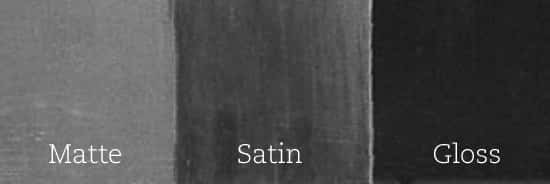
Different varnish finishes on black paint
This matte finish that tin can oftentimes appear in acrylics is the same equally areas of an oil painting that have 'sunk in'.
This is often why dark, dramatic paintings have a final glossy moving picture varnish applied. It brings back the colours and makes the blacks look really black.
If y'all endeavor to apply a satin or matte varnish to a black painting, the blackness level will be lifted.
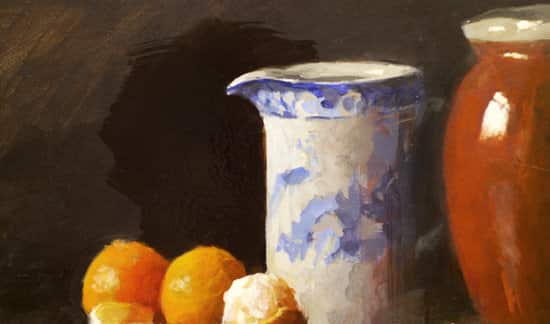
Notice the deviation in intensity of the black in a higher place, depending on the varnish.
And then what approach do I take?
I utilise an isolation coat, which will always be gloss.
Then get out information technology to dry for 24hours so I can assess the level of sheen that will best suit the painting colours and the environment the painting will hang (if information technology'due south a specific commission). It'southward worth considering bright lights within the hanging space, as these can ofttimes cause a glare on a too glossy finish.
About of the time, I would so mix a bespoke solvent-based varnish by calculation matte varnish to a gloss varnish. And so, in essence, creating a controllable satin finish.
I utilise sparse coats, sometimes three or 4, e'er assessing when it's dry whether I'm happy with the level of sheen/colour saturation compromise.
3. Protect the painted surface from atmospheric furnishings to make the surface easier to make clean.
Acrylic paint, past its very nature, is quite a soft material. If y'all have a blob of acrylic paint that is dry, yous tin can still push it and squeeze it, and it will motility.
There are 2 main choices for your acrylic painting—either a h2o-based varnish or a solvent-based varnish.
Water-based varnish (Polymer)
H2o-based varnishes usually are created from an acrylic polymer, similar in consistency to an acrylic glazing liquid.
They provide a skillful level of protection and for pocket-sized to medium pieces are an easy, dandy choice, specially if you work from a minor studio within your home.
They are convenient, cleanup friendly and don't scent strong; however, they are harder to apply evenly on larger areas with a brush as they dry as well quickly for big canvases.
They are besides milky white when applied, drying to clear with a tendency to foam when mixed (so often need to exist left to settle before applying)
They don't give as hard a surface finish as a solvent-based varnish.
Some polymer varnishes need to be thinned before use (Aureate Polymer Varnishes need to be thinned) as they are manufactured to be thicker in the pot so there is greater consistency to the varnish moving picture when it is thinned and practical.
Thinning with water (ideally distilled water):
- 3 Parts Varnish
- 1 Role (distilled) Water.
Pro tip: If you're having problems working quickly plenty with water-based varnishes, so you can use a large sponge to apply.
This but works if you lot're using a water-based varnish that is already quite fluid. You need to piece of work quickly and be patient to build upward the varnish in thin layers. Be careful using a sponge with an isolation coat equally it can atomic number 82 to foaming.
Pros
Clean up with water
Dry speedily
No strong smell
No need for mineral spirits for cleaning
Cons
Catchy to apply
Dry out very quickly
Not as hard varnish finish
Milky when wet
Solvent-based varnish (MSA)
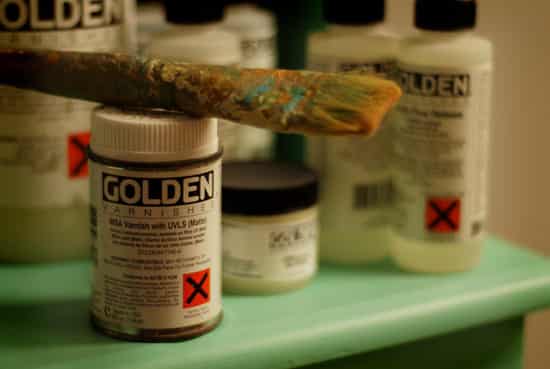
Solvent-based varnishes or Mineral Spirit Acrylic varnish dry to a tough withal flexible layer.
MSA varnishes are articulate when moisture and also provide an easier application with self-levelling qualities. The clarity and appearance of the finish are slightly superior compared to a h2o-based varnish.
The biggest drawback with MSA Varnishes is that they must be thinned before use, with full strength spirits. They are strong-smelling, and clean up is messy and then that home use can be impractical.
Hither is a demo video from Golden paint showing how to correctly sparse Mineral Spirit Varnish:
And this video shows you what tin can go wrong when thinning Golden MSA varnish of yous use Odourless Mineral Spirits:
Pros
Easier to apply
Cocky-levelling qualities give an even sheen
Slow drying so are excellent for big pieces
Hard varnish stop
Cons
Have to thin with full-strength spirits before using (not odourless mineral spirits)
Clean up using solvents
Potent smell
Not as cleanup friendly in a home (a bit messy)
If your varnished painting looks a little uneven or the end isn't absolutely perfect, don't exist likewise hard on yourself – spare a little thought for Renoir.

Within the French Academy, before the official opening of the Salon exhibition, artists were allowed a varnishing day. The artist's colourmen often carried this out.
Cezanne'southward fine art dealer Vollard quotes Renoir from 1879:
"The mean solar day before the opening, a friend came and told me that he had just been to the Salon, and that something queer seemed to have happened to my Mademoiselle Samary. I dashed to the Salon and establish the picture almost beyond recognition – it looked as if it were melting abroad. It seems that the framer instructed the delivery boy to varnish another picture that he was delivering at the same time. The male child had a little varnish left over and decided to give me the do good of it.
I didn't varnish mine because it was still wet, simply he thought I was beingness economical! The result was I had to pigment the whole thing in an afternoon."
So my bubble wrap bubble marks over my piece don't seem then disastrous afterwards all!
I promise this helps when deciding to varnish your own works.
Source: https://willkempartschool.com/how-to-varnish-an-acrylic-painting-like-a-pro/